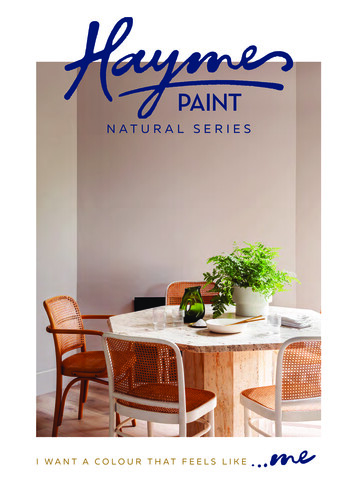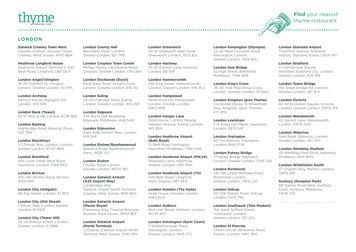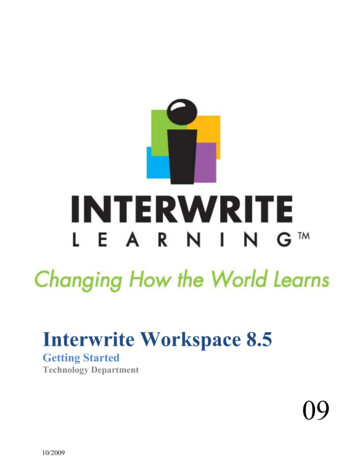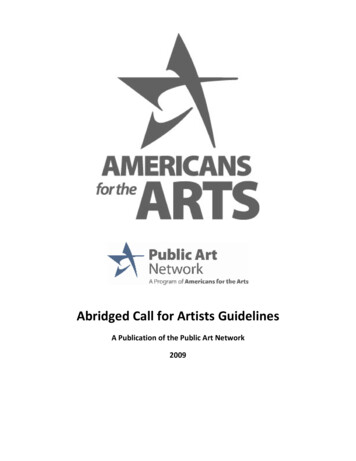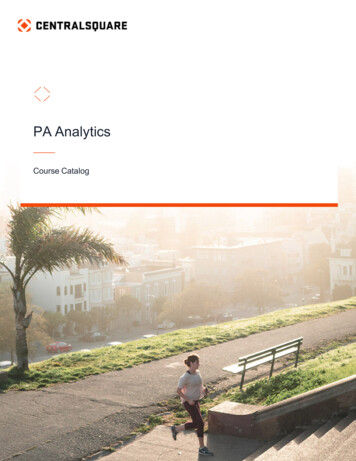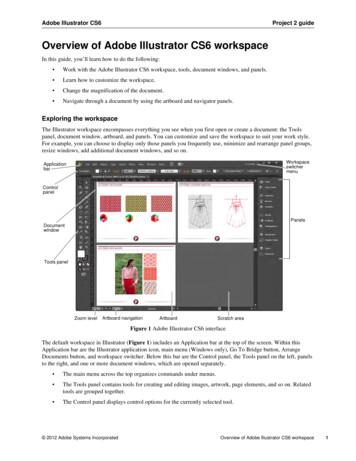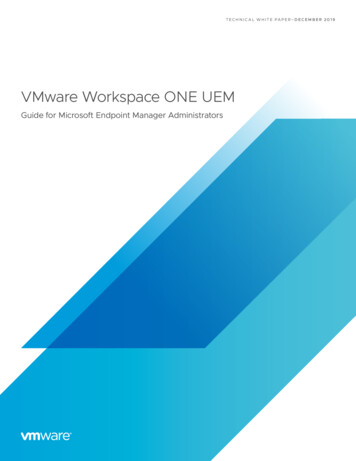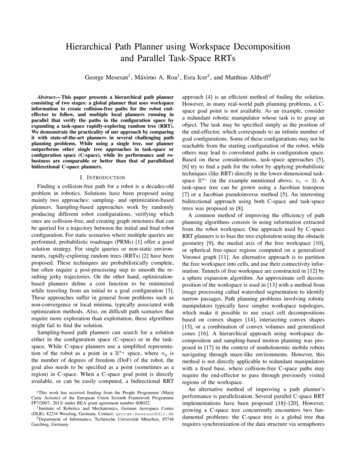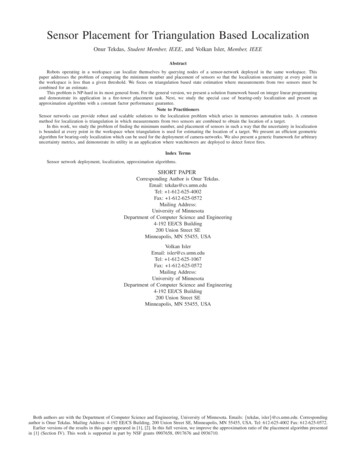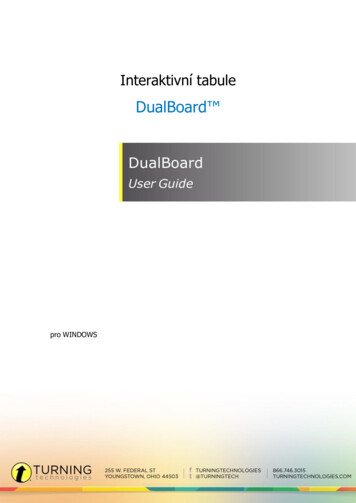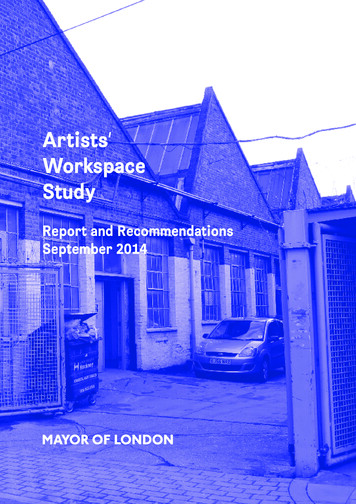
Transcription
Artists’WorkspaceStudyReport and RecommendationsSeptember 2014
Greater London AuthoritySeptember 2014Greater London AuthorityCity Hall, London SE1 2AAwww.london.gov.ukenquiries 020 7983 4100minicom 020 7983 4458Study and report prepared byVVe Made That LLP30-32 Stamford RoadLondon N1 4JLT 44 (0)20 7249 6336www.wemadethat.co.ukAcknowledgementsThe team wishes to express their thanks toall the businesses and arts practitionersthat gave their time to participate in thecreation of this study.
ContentsForeword5Executive Summary7IntroductionSurvey MethodologyKey Definitions and Parameters111. Initial AuditSummary of OutcomesBreakdown of Gathered Data152. Detailed SurveySummary of OutcomesBreakdown of Gathered Data31Studio Typologies39ACharitable/ non-profitBCommercialCSelf-organised/ artist-led studiosDResidency spaceETemporary occupationFFacilities & skillsGLive/ work schemeHVoluntary/artist led co-operativeICultural benefit & exchangeJHigh street peripheriesKNew build planning gainLSignificant artist supportSuggestions for Further Research55Recommendations57
ForewordLondon is riding high on its creativecredentials, with the creative and culturalindustries contributing 21bn in London alone.One in six new jobs in London is in the creativeindustries. In 2013 London was the most visitedcity in the world with 18 million visitors, andeight out of ten overseas visitors named cultureas the key driver for their visit. The Mayorhas stated that the arts are part of London’sDNA, but what would the arts be without thethousands of artists who live and work here?For hundreds of years London has been apremier destination for painters, sculptors,dancers, musicians and performers fromaround the world. The thriving commercialcreative sector is underpinned and enrichedby these artists. They share ideas andtechnologies, feed off each other and worktogether in complex ways. From scenicartists working at the Royal Opera Houseto designers of floats for the Notting HillCarnival and sculptors creating majorexhibitions for Tate, the artists working instudios sustain a range of ancillary smallbusinesses, including framing, conservation,insurance, shipping, and security -all ofwhich are vital to London and the UK.With London’s population due to reachnearly 10 million in the next decade,affordable workspace has become a keyissue, putting particular pressure on creativesmall businesses, which includes artists.Whether showcasing fashion designersto international audiences, funding newapprenticeships in animation, promoting thecapital’s design businesses or lobbying forthe preservation of creative hubs, the Mayor’soffice is intervening across the creativeindustries to ensure that London remains acapital of cultural content.Directors of our major cultural institutionshave voiced concerns about the gradualexodus of artists out of central London andthe attractiveness of other global cities thatoffer more space at cheaper rents. Manyare worried that artists are victims of theirown success, moving into affordable areas,contributing to gentrification and then beingforced out with rising prices. This study doeslittle to allay these fears, showing that asmany as 3500 artists are likely to lose theirplaces of work in the next 5 years - 30% ofthe current provision.More worrying than the loss of spaces, though,is the loss of talent. We risk a city filled withwonderful, world renowned institutions andbuildings, but no living, breathing artisticcommunity to keep them alive.The experience of other cultural capitals likeNew York, Berlin and Montreal indicates thatthere are some key ways of addressing thisproblem - tactical interventions includingplanning protection, direct investment inunder-occupied buildings and creative usesof city-owned properties. This report showsthe level of ingenuity and commitment oforganisations supporting artists’ workspace,including workspace providers, LocalAuthorities and enlightened developers.It highlights the complex and often highlyinnovative approaches required to make thesespaces work. We have an opportunity to buildon London’s unique strengths as a world leaderfor culture to find a new sustainable modelwhich allows us to keep artists at its heart.Artists have been part of London’s storyfor hundreds of years and have made it thethriving, creative, diverse city it is today.With the creative sector’s huge contributionto London’s economy and global position wesimply cannot afford to lose them.Munira MirzaDeputy Mayor for Education and Culturep. 5
In London29811,500Separatestudio buildingsPeople working fromartists’ workspaces3,220 21.4 bnArtistsin premises at risk17%Premises are ownedby freeholdContribution of thecreative industries1 in 6New jobs are created inthe creative industries35,000 13.73Average rentper sq ft per annump. 6Artists’ Workspace StudyGraduates from Artand Design Collegesevery year
Executive SummaryThis Artists’ Workspace Study provides asnapshot of affordable studio provision forartists in London in 2014.Existing Supply – the current state of playThe survey has uncovered that the supplyof artists’ studio space in London is higherthan previously recorded. We recorded 298separate studio buildings or sites, cateringfor over 11,500 artists across the capital.Artists’ workspace is a diverse fieldgenerally characterised by scarce resources.Studio providers and artists have thereforedeveloped a number of models to ensurethat space remains affordable, for examplethrough tenancy, management, premises orfacilitation. Many providers have charitable ornot-for-profit status and seek external fundingin order to support aspects of their work.Many also provide much more thanstraightforward space – open accessfacilities, performance venues, productionspace, galleries and cafes. Time and againstudios and the artists working withinthem have been found to make valuablecontributions to community cohesion,creating vibrant and active places. However,artists are often indirect victims of their ownsuccess, and having contributed to positiveplace making in an area, may find that theyare no longer able to afford to remain thereonce property values begin to rise.Vulnerability – a precarious situationThe affordable artists’ workspace sector asa whole occupies premises with a range oftenures: 51% on rented or otherwise licensedterms. This makes many studios vulnerableto change of use or development should thelandowner consider more profitable uses.Even amongst the 20 largest artists’workspace providers, secure tenure ofpremises was an issue, with 35% of theirproperty stock reportedly under threat withinthe next 10 years. Furthermore, within thenext 5 years 28% of artists’ studios are underthreat as operators do not expect to be ableto renew leasehold/ rental agreementsto secure their premises, demonstratingthe precarious nature of affordableartists’ workspace. Increasing land valuesacross London, particularly for residentialdevelopment, are likely to increase pressureon the sector, as discrepancy between theincome potential from artists’ workspace andother forms of development becomes larger.Threats and vulnerability extend beyondproperty tenure. Artists are among the lowestearners, most making under 10,000 per yearfrom their work 1, so it is crucial to keep thecost of workspace low. Most studio providersoperate within a complex web of fundingstreams as well as public investment rangingfrom grants to Section 106 allocations inorder to maintain low rents.Affordability – what does it mean?Affordability is a key deciding factor in themodels of artists’ workspace provision. It isoften prioritised over long term security andquality of space.The average rent across the main studioproviders is 13.73 sq ft per annum, thougha significant amount of studio space (19%) isrented at 8 per sq ft. The cost of utilities is anadditional costs artists pay beyond the averagefigure above. These costs vary in relation tocondition of building, occupation periods andarts practice. This is significant when lookingacross the incubator and co-working sector,where comparable rents are often at least 30sq ft per annum depending on the size and1National median wage for a fine artist in 2010,‘Artist Salary Research’, DACS 2010p. 7
type of space and the level of support involved2.Compounding the challenge of affordableworkspace is the overall cost of living whichhas a significant effect on artists’ abilityto live and work in London. Some artists’workspace providers do include residentialprogrammes as part of their developments,though such schemes are rare in the capital.While many artists make their living througha variety of related occupations, it isimportant to recognise the potential for allartists to fully support themselves throughtheir artistic work. In this sense, artists’workspace should be regarded as part of thewide spectrum of low threshold enterprisespace. Creating conditions in which artistscan dedicate more time to their artisticcareer can increase economic success andcontribute to London’s cultural capital.Demand – no end in sightFurther research is needed to determinethe actual demand for artists’ workspace.Studios in our study show very highand continuous occupancy rates,indicating consistent levels of demand.An estimated 3500 artists are on waitinglists. Furthermore, each year 35,000students graduate from Art & DesignColleges in London 3. This, combined withhigh occupancy rates, gives a picture ofsustained pressure on studio and workspaceprovision. There is no indication that thelevel of demand has decreased within thelast 10 years - our research shows thatthere are 298 separate studio buildings orsites operating in London.There is a dynamic relationship betweenan artist’s studio, home and other places of23p. 8‘Supporting Places of Work: Incubators,Accelerators and Co-working spaces’, URS, 2014pg. 110 ‘World Cities Cultural Report’, Mayor ofLondon, 2010Artists’ Workspace Studywork that commonly forms a geographicaltriangle, all impacting on the choices madewhen seeking a working space. Artists arealso reliant on professional networks anddialogue within the creative community, solocation can be inextricably linked to careersuccess. Further research is required onoccupancy analysis as well as on the type,scale and location of space requirementsbest suited to artists’ needs going forward.Some of the recommendations made hereare linked to the need for more researchto give further depth and understandingof current and future provision in London.However, having established the loss of over3000 places of work in this sector withinthe next 5 years, immediate intervention isneeded.Affordable artists’ workspace is a valuable,yet vulnerable asset in London. This reportdemonstrates that the sector is largelyreliant on providers operating on a not forprofit or charitable basis in order to keeprents within reach. Given the ever increasingproperty values across London, it is clearthat the market will not by itself addresssustained provision, thus jeopardising thiskey component of London’s cultural andsocial vibrancy. Many of the organisationswhich provided information for this studyhave worked intensively with public sectorpartners, as well as private developers,to realise their buildings. The importanceof public sector involvement in this areacannot be overstated. The key issues arisingare how to:1. GrowMaintain and grow supply of spaces with along term view – 3500 spaces in the next fiveyears at a minimum.2. StrengthenReduce vulnerability through changes inplanning and rising property values – one
example might be to work with publiclyowned property or land.3. InfluenceBuild on existing models of workspaceprovision to make the case to developersand Local Authorities alike and influencefuture development.4. FacilitateLink appropriate providers with the correctfacilities, whether in new developmentsor existing buildings, to achieve the bestvalue for the wider community. This shouldbe considered alongside potential forcomplementary local place making.5. ImagineDevelop a new, imaginative solution forLondon’s particular ecology based on thelevel of workspace provision needed.p. 9
p. 10Artists’ Workspace Study
IntroductionObjectivesThis Artists’ Workspace Study aims toestablish an accurate picture of affordablestudio provision for artists in London.The intention is that this will create a list ofall London’s Artist Studios on the Mayor’s‘London.Gov’ website that can cohabit witha related study on Incubators, Acceleratorsand Co-working spaces, in the form of aninteractive map. This will give an accuratepicture of current supply of low-thresholdworkspace, thereby helping the GreaterLondon Authority understand future demandsaround affordable workspace provision.The ultimate aim is that this evidence - whencombined with further research - can beused to better understand the significanceof affordable artists’ workspace to London’scultural offer, to identify risks to its futureprovision and to make recommendations tosupport a vibrant future for London’s artistpopulation.Report StructureThis report is presented in the followingsections:Initial Audit - Given the limited timescaleswithin which this study has been undertaken(March - April 2014), the study began withan exercise to quickly establish an accurateoverview of type and location of artists’studios within London.Detailed Survey - Having gained an overallpicture of artists’ studio space in Londonthrough the Initial Audit, the 20 largestartists’ workspace providers were reapproached to provide more detailedquantitative and qualitative informationabout their premises.Studio Typologies - From both the InitialAudit and the Detailed Survey, we have beenable to identify a number of differing modelsand features of artists’ studio provision.This section summarises key points of eachtype, which must be understood if suitablerecommendations are to be made to supporttheir futures.Recommendations - Based on the KeyFindings, here we recommend stepsto extend and continue this study, andpotential methods to support London’sartists’ studio space provision in the future.p. 11
Survey Methodology1. Initial AuditThis initial undertaking was devised to quicklyand accurately ascertain an overview of typeand location of artists’ studio workspaceacross London. The information collectedthrough this survey was intentionally simpleto ensure high provider participation inestablishing an overview.Using an online form and automatedspreadsheet populating setup, We MadeThat, the Greater London Authority, localauthorities, artists’ workspace providers andoccupiers were able to register basic detailsof artists’ studios as part of this audit.The online form could be used to be furtherpopulated directly and independently byproviders and the Greater London Authorityafter the initial round of completedresearch. This can be used to continueto build a picture of artists’ studiosacross London, where studios are oftenindependent, informal or not part of widernetwork, and can therefore be difficult tolocate.The initial audit form is available to view andaccess qEazvUTefHc3NnNcJGkK0iyGPu1V73o/editp. 12Artists’ Workspace Study2. Detailed SurveyThis portion of the study adds depth to thegathered directory from the Initial Audit. Adetailed follow-up focused on the 20 ‘toptier’ artists’ workspace providers in terms ofnumber of artists’ studio workspaces. Thequestionnaire was tailored to the findingsof the initial audit and was also consistentwith elements of the recent Incubators,Accelerators & Co-working Spaces study.Using the contact details submitted in theinitial stage, the 20 largest providers wereapproached by phone and followed up byemail. A further online form was providedand details were gathered under thefollowing headings:1. Studio provider profile2. Basic information about the premises3. Artists’ rent and waiting lists4. Profile of occupants5. Facilities, provision and managementThe online form was also provided to smallerartists’ workspace providers who opted-into participating in the detail survey. Thesame questionnaire was used, but was notfollowed-up by phone.The detailed survey form is available to viewand access 0mBsbFHiMA3NLSI59cVrQkTxsBSo6q8/viewform
Key Definitions and ParametersDefining ‘Artists’The purpose of this study is to gain a wideranging understanding of the kinds of spacesthat it is possible for artists to work in. Thedriver is to understand pressures on artists’workspace and the gap in affordabilitybetween market values and viable rent levelsin spaces for making art.The emphasis in this study is on the fine artistwhose visual output and medium ‘involvesthe production of original works of research,exploration or artistic expression, either oneof-a-kind or in a limited number of copies,conveyed through painting, sculpture, theprint arts, drawing, illustration, photography,textile arts, installations, performance, digitalarts, interactive arts, sound art, video art,interdisciplinary arts or any other form ofexpression of a similar nature.’ 1We understand there are crossoversbetween fine artists and craft disciplinesand there are ‘a multitude of differentcultural workers who play an essential rolein the chain of artistic creation but are notspecifically designated as artists.’ 2Given the necessity to understand the viabilityof a spectrum of artistic practices in London,artistic practices in this context are ‘notdriven by commercial gain (although they areby no means prohibited from having this). Theapproach to the production of art is driven bythe artist, not the client.’3We recognise that there will inevitably be123pg. 7 ‘Montreal Metropole Culturelle Reporton Artists’ Studios’, by the Task Force on ArtistStudios, October 2012pg. 8 ‘Montreal Metropole Culturelle Reporton Artists’ Studios’, by the Task Force on ArtistStudios, October 2012pg. 9 ‘Research and viability study ofaffordable and managed workspacessupporting artistic practices in EastLondon’, by Renaisi for LLDC, February 2014a range of activities taking place in studiospaces within this variegated sector. Evenamongst top tier artists’ workspace providers,there are varying attitudes towards fine artpractice and wider creative design and craftpractices being undertaken in affordableworkspace. For the purposes of this study,we have therefore primarily discriminated onthe basis of affordability, rather than activity.As such, spaces included in this survey, maynot be predominantly occupied by artists,provided that they meet the criteria below.Affordable artists’ workspaceWe are particularly interested inunderstanding differing models of providingaffordable artists’ space. We recognisethat the opportunities and challenges insupporting all kinds of creative space isnot a one-size-fits-all equation, but for thepurposes of this study some parametershave been defined to ensure robustrecommendations can emerge from thesurvey.Therefore, the following parameters must bemet for inclusion in this particular study:— — Premises/ Organisation must providefor a minimum of at least five artists’studios or support five artists (even ifother workspace or living provision isincluded in the building).— — The studio workspace cannot besubsidised/ affiliated with educationinstitution for the sole use of graduatesor students. It must be available toaccess on the open market, althoughsome selection criteria may apply.p. 13
1. Initial AuditSummary of outcomesAudit ResponsesThis Initial Audit revealed the extent ofartists’ workspace provision in London asbeing far higher than previously recorded(112 studio buildings estimated in 2010 1,and 72 studio buildings estimated in 2004 2).However, there is a need for some caution tobe exercised when comparing these studiesas they have used differing parameters forinclusion of studios.— — This audit has identified 298 separatestudio space sites/ buildings in London.—— 76 organisations responded to the audit. Theyprovide 219 studio space sites/buildings,encompassing more than 6070 studio spaces.— — The audit directly identified studioprovision for at least 8600 artists. It canbe expected that this figure is below theactual number of artists ‘profiled’ (atapproximately 11,500).—— The 20 largest artists’ workspace providersmanage premises manage 129 separatestudio space sites/ buildings betweenthem. These account for 60% of providedartists’ studios and artists in London.— — We have ‘profiled’ a further 79 studiospace sites/ buildings in London throughour research. We have not been able toprocure data from these for the purposesof this audit beyond post codes.—— We recognise that the amorphousand changeable nature of how artists’workspace is provided means that thisaudit is not exhaustive, and that otherstudios will exist beyond those identified.12pg1, 2010 NFASP survey results,Key findingsand conclusionspg7, LONDON DIGEST: A survey of artists’studio groups & organisations inLondon, Acme, 2004Organisation typeThe Audit shows that provision of affordableartists space is primarily met by charitableor not-for-profit organisations.— — More than 82% of artists’ workspaceproviders explicitly aim to supplyaffordable space, or provision throughcharitable or not-for-profit endeavours.— — Only 5 organisations class themselvesas a ‘Commercial workspace providersor Developers’. The term ‘entrepreneurial’would better articulate the approachthese organisations take in providingaffordable artists’ workspace.—— A fair characterisation of the lower 40% ofprovision would typically be insecure shortterm tenancy, single building operators.Premises tenureLack of security in premises tenure is acommon feature in the sector, although thismay be directly related to its affordability.—— 51% of artists’ workspace organisations areoperating from rented, or otherwise licensed,space and therefore lack long term security.— — 17% are owned under freehold.Average studio rentThere is a trend towards increasing rentalvalues in comparison with previous studies.—— In 2004 the average studio rent was 7.54per sq. ft per annum, in 2010 this averagewas identified as 9.72. Adjusted forinflation, this would equate to 10.10 persq. ft per annum in 2014 terms.— — This audit has found that more than half(56%) now have average studio rent ofmore than 11 per sq. ft per annum.p. 15
0p. 16Artists’ Workspace StudyCobstudiosSee StudioSouthlands Arts CentreTURF ProjectsLondon Centre for Book ArtsUsurp ArtThe Papered Parlour] performance space [The Old School ClubCre8 Life Style CentreThe CockpitMentmore Studios330 StudiosVision RCLManor Farm Craft StudiosTM StudiosDalston Underground ProvidersThe Arches, Blenheim GroveDelfina FoundationThe Forge & Artists StudiosMagenta ArtGasworksThe Dye HouseFlorence TrustDiesel House StudiosSouthgate Studios90 Main YardA-side B-side GalleryBrentford Gallery & StudiosCollective StudiosTannery ArtsCreate Space LondonStudio VoltaireCity StudiosCubitt StudiosThe Mill Co. ProjectCommonwealth StudiosRedless StudiosChisenhale Art PlaceWhirled ArtThe Old Police Station401 StudiosA.P.T. - Art in Perpetuity TrustSouthwark StudiosLewisham Art HouseCopeland ParkLighthouse StudiosMother StudiosVanguard Court StudiosArt HubMake Space StudiosBarbican Arts Group TrustEuroart StudiosNW10 and Northwest Studios Ltd.Hackney Downs StudiosGreat Western StudiosChocolate Factory ArtistsV22Cockpit ArtsCell Project spaceWimbledon Arts StudiosBow ArtsSecond Floor Studios and Arts (SFSA)SPACEACAVAACME StudiosASC - Artists Studio CompanyDistribution by ProviderNumber of studiosAll respondents to survey600400200
Average Studio RentsArranged by per sq ft per annumRespondents from Part 1 Audit(note detailed analysis later in this 1.8%FreeLess than 8 8 - 11 11 - 19More than 19p. 17
Premises Tenure% type by organisation’s main portfolioRespondents from Part 1 AuditPremises tenure (by organisation’smain portfolio holding)OtherFreehold6%17%45%Rental agreement32%Leasehold agreementFreeholdLeasehold agreementRental agreementExplanatory note:Respondents were requested to select to theabove terms of premises tenure. This studyinterprets these as ‘Freehold’; ownership ofthe property, ‘Leasehold agreement’; wherethe provider has a business tenancy for afixed-term (e.g. 10 or 25 years) and wherep. 18Artists’ Workspace StudyOtherrent is paid and it may or may not be that atthe end of term the tenancy can be renewed,‘Rental agreement’; where short-term orinformal agreements, which are essentiallyinsecure, and where notice may be given atany time.
Geographic DistributionBy number of studiosAll 288HaveringEaling2395978hamBarking stminster29RBKCHam.& Barking CroydonSutton12Bromley1Bromley0Less than 100LessLessthanthan10101111 --50505151 --10010011 - 5051 - 100101 - 500More than 501101101--500500MoreMorethanthan501501p. 19
Artists’ workspaces overviewACME Matchmakers Wharf, HackneyStudios 49Artists 57A.P.T - Art in Perpetuity Trust, LewishamStudios 42Artists 43Studio Voltaire, LambethStudios 30Artists 63A.P.T - Art in Perpetuity Trust, LewishamStudios 42Artists 43Hackney Downs Studios, HackneyStudios 100 Artists 300Bow Arts SE1 Studios, SouthwarkStudios 110 Artists 140p. 20Artists’ Workspace Study
Brentford Gallery & Studios, HounslowStudios 16Artists 18Euroart Studios, HaringeyStudios 70Artists 80Brentford Gallery & Studios, HounslowStudios 16Artists 18Make Space Studios, LambethStudios 64Artists 95Chisenhale Art Place, Tower HamletsStudios 40Artists 40Make Space Studios, LambethStudios 64Artists 95p. 21
Redlees Studios, HounslowStudios 38Artists 38Second Floor Studios & Arts 2, GreenwichStudios 390 Artists 400Redlees Studios, HounslowStudios 38Artists 38330 Studios, SouthwarkStudios 6Artists 6Southwark Studios, SouthwarkStudios 43Artists 50Southwark Studios, SouthwarkStudios 43Artists 50p. 22Artists’ Workspace Study
The Old Police Station, LewishamStudios 41Artists 50The Old School Club, WandsworthStudios 1Artists 8V22 Axion House, LewishamStudios 62Artists UnspecifiedGasworks, LambethStudios 11Artists 12V22 Drummond Road, SouthwarkStudios 20Artists 25Gasworks, LambethStudios 11Artists 12p. 23
401 Studios, LambethStudios 42Artists 46401 Studios, LambethStudios 42Artists 4690 Main Yard, HackneyStudios 15Artists 23ASC Artists Studio Company, SouthwarkStudios 120 Artists UnknownASC Artists Studio CompanyStudios 700 Artists 950ACAVA Blechynden Street Studios,Kensington and ChelseaStudios 20Artists 24p. 24Artists’ Workspace Study
ACAVA Blechynden Street Studios,Studios 20Artists 24Artistic Spaces Ltd Unit 10, LewishamStudios 100 Artists 5Cockpit Arts, CamdenStudios 170 Artists 170Chocolate Factory Artists, HaringeyStudios 130 Artists 180Cockpit Arts, CamdenStudios 170 Artists 170Create Space London, BrentStudios 28Artists 30p. 25
Create Space London, BrentStudios 28Artists 30Dalston Underground Studios, HackneyStudios 8Artists 12Delfina Foundation, WestminsterStudios 8-10 Artists 8Florence Trust, IslingtonStudios 12Artists 11Florence Trust, IslingtonStudios 12Artists 11Great Western Studios, WestminsterStudios 106 Artists 45 (capacity 300)p. 26Artists’ Workspace Study
Lewisham Arthouse, LewishamStudios 46Artists 52Lewisham Arthouse, LewishamStudios 46Artists 52Lighthouse Studios, HackneyStudios 65Artists 200London Centre for Book Arts, Tower HamletsStudios 1Artists 12Mentmore Studios, HackneyStudios 4Artists 47SPACE Arlington, IslingtonStudios 13Artists 13p. 27
Tannery Arts, SouthwarkStudios 25Artists 40The Papered Parlour, LambethStudios 2Artists 24Usurp Art, HarrowStudios 2Artists 10Vision RCL, RedbridgeStudios 6Artists 9Wimbledon Art Studios, WandsworthStudios 228 Artists 260p. 28Artists’ Workspace Study
p. 29
2. Detailed SurveyLargest ‘top tier’ artists’workspace providersThrough the Initial Audit, the 20 largestartists’ workspace providers - based onthe number of artists’ studios under theirmanagement within London - were identifiedto participate in the Detailed Survey.These alone account for 129 individual sites/buildings housing artists’ studios, containing4330 studios and more than 6000 artists, asfollows:10. V225 sites/ buildings129 studios11. Chocolate Factory / Collage Arts2 sites/ buildings130 studios12. Great Western Studios1 sites/ buildings106 studios1. ASC - Artists Studio Company12 sites/ buildings671 studios13. Hackney Downs Studio4 sites/ buildings100 studios2. ACME Studios14 sites/ buildings504 studios14. NW10 & Northwest Studios Ltd4 sites/ buildings90 studios3. ACAVA20 sites/ buildings491 studios15. Vanguard Court Studios11 sites/ buildings50 studios4. [ space ]18 sites/ buildings468 studios16. Euroart Studios1 sites/ buildings70 studios5. Second Floor Studios & Arts (SFSA)8 sites/ buildings390 studios17. Makespace Studios /Studio 1803 sites/ buildings64 studios6. Bow Arts Trust7 sites/ buildings320 studios18. Barbican Arts Group Trust3 sites/ buildings65 studios7.19. Art Hub3 sites/ buildings66 studiosWimbledon Art Studios2 sites/ buildings228 studios8. Cell Project Space7 sites/ buildings175 studios20. Mother Studios2 sites/ buildings43 studios9. Cockpit Arts2 sites/ buildings170 studiosp. 31
Summary of OutcomesOrganisation structureThe 20 largest artists’ workspace providersaccount for the majority of London’s artists’studios (58% of total number surveyed).mixed use development (inc. studentaccommodation and residential), butthis currently only accounts for 186artists studios (around 224 artists).— — The 20 largest artists’ worksp
artists in London in 2014. Existing Supply - the current state of play The survey has uncovered that the supply of artists' studio space in London is higher than previously recorded. We recorded 298 separate studio buildings or sites, catering for over 11,500 artists across the capital. Artists' workspace is a diverse field
